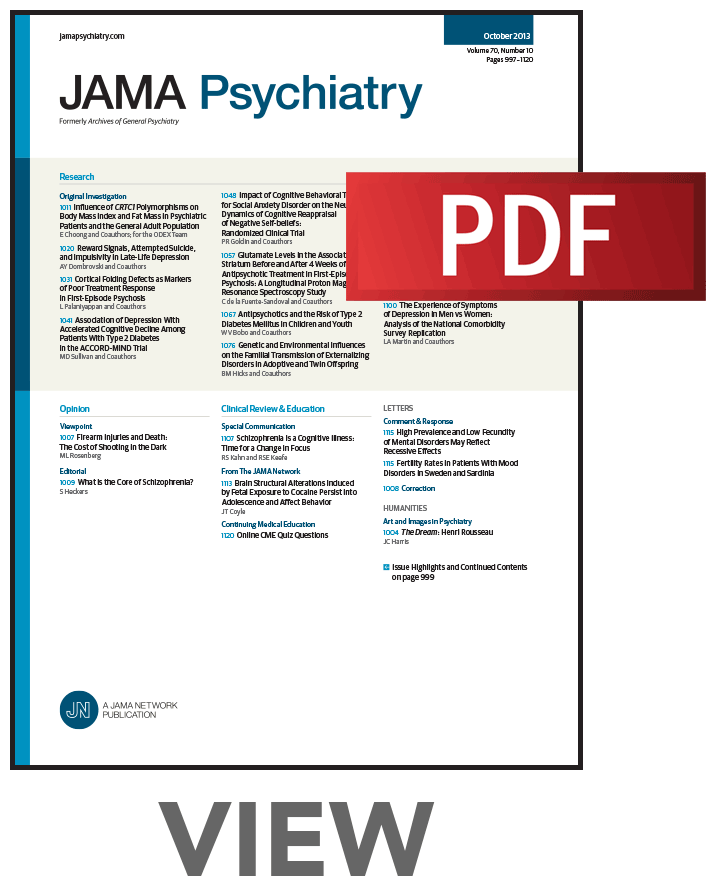High-Intensity Exercise and Hippocampal Integrity in Adults With Cannabis Use Disorder: A Randomized Clinical Trial.
IF 17.1
1区 医学
Q1 PSYCHIATRY
引用次数: 0
Abstract
Importance Cannabis is the most commonly used illicit drug, with 10% to 30% of regular users developing cannabis use disorder (CUD), a condition linked to altered hippocampal integrity. Evidence suggests high-intensity interval training (HIIT) enhances hippocampal structure and function, with this form of physical exercise potentially mitigating CUD-related cognitive and mental health impairments. Objective To determine the impact of a 12-week HIIT intervention on hippocampal integrity (ie, structure, connectivity, biochemistry) compared with 12 weeks of strength and resistance (SR) training in CUD. Design, Setting, and Participants This randomized, single-blind, comparator-controlled clinical trial (Brain Exercise and Addiction Trial [BEAT]) assessed the efficacy of a 12-week exercise intervention for improving hippocampal integrity. Participants were adults with moderate to severe CUD and were not required to cease cannabis consumption. In-person assessments and interventions were conducted at Monash University's BrainPark facility (Melbourne, Australia). The trial was conducted from 2018 to 2022 and the data analysis from September 2022 to February 2023. Intervention HIIT (3 times a week, high lactate condition) for 12 weeks, compared with 12 weeks of SR (3 times a week, low lactate, active control condition) to 12 weeks. Exercise interventions were supervised by exercise physiologists and tailored to target specific (lactate) and personalized physiological mechanisms. Main Outcomes and Measures The primary outcome was hippocampal integrity as indicated by a composite of 3 magnetic resonance imaging (MRI) measures: anatomical volume, fractional anisotropy, and N-acetylaspartate. Secondary outcomes included cognitive and mental health measures. Outcomes were assessed at baseline and at the end of the intervention. Adverse events were tracked throughout participation. Results Fifty-nine participants with moderate to severe CUD were randomized 1:1 to receive HIIT or SR. The mean (SD) age was 27.0 (6.3) years (range, 20-53 years); 47 participants (80%) were male and 12 (20%) female. Overall, 47 participants (80%) completed the 12-week intervention, attending a mean of 29 of 36 exercise sessions (80%). Hippocampal integrity did not increase after 12 weeks of HIIT (estimated marginal means [SE], -0.14 [0.43] at baseline; 0.10 [0.45] after intervention) or SR (0.38 [0.37] at baseline; -0.16 [0.37] after intervention). Conclusions and Relevance This trial found that a 12-week HIIT intervention did not improve hippocampal integrity or associated cognitive or mental health impairments while people continued to consume cannabis. However, results indicated that people with CUD can engage in regular physical exercise programs and highlighted exercise as a potential strategy to reduce cannabis craving. Trial Registration ClinicalTrials.gov Identifier: NCT04902092.成人大麻使用障碍的高强度运动和海马完整性:一项随机临床试验。
大麻是最常用的非法药物,10%至30%的经常使用者患有大麻使用障碍(CUD),这种疾病与海马完整性改变有关。有证据表明,高强度间歇训练(HIIT)可以增强海马的结构和功能,这种形式的体育锻炼可能会减轻cudd相关的认知和心理健康损害。目的比较12周的强度和阻力训练对CUD患者海马完整性(即结构、连通性、生物化学)的影响。设计、环境和参与者这项随机、单盲、对照临床试验(脑运动和成瘾试验[BEAT])评估了为期12周的运动干预对改善海马完整性的疗效。参与者是患有中度至重度CUD的成年人,不需要停止吸食大麻。在莫纳什大学BrainPark设施(澳大利亚墨尔本)进行了现场评估和干预。试验时间为2018年至2022年,数据分析时间为2022年9月至2023年2月。干预hiit(每周3次,高乳酸状态)12周,与SR 12周(每周3次,低乳酸状态,积极对照状态)相比至12周。运动干预由运动生理学家监督,并针对特定目标(乳酸)和个性化生理机制进行定制。主要结果和测量主要结果是海马的完整性,通过3种磁共振成像(MRI)测量的组合来显示:解剖体积、分数各向异性和n -乙酰天冬氨酸。次要结果包括认知和心理健康测量。在基线和干预结束时评估结果。在整个参与过程中追踪不良事件。结果59例中重度CUD患者按1:1随机分为HIIT或sr组,平均(SD)年龄为27.0(6.3)岁(范围20-53岁);47名参与者(80%)为男性,12名参与者(20%)为女性。总体而言,47名参与者(80%)完成了为期12周的干预,平均参加了36次锻炼中的29次(80%)。HIIT 12周后,海马完整性没有增加(估计边际均值[SE],基线时为-0.14[0.43];干预后为0.10[0.45])或SR(基线时为0.38[0.37];干预后为-0.16[0.37])。结论和相关性本试验发现,当人们继续吸食大麻时,12周的HIIT干预并没有改善海马完整性或相关的认知或精神健康损伤。然而,研究结果表明,CUD患者可以定期进行体育锻炼,并强调锻炼是减少对大麻渴望的潜在策略。临床试验注册号:NCT04902092。
本文章由计算机程序翻译,如有差异,请以英文原文为准。
求助全文
约1分钟内获得全文
求助全文
来源期刊

JAMA Psychiatry
PSYCHIATRY-
CiteScore
30.60
自引率
1.90%
发文量
233
期刊介绍:
JAMA Psychiatry is a global, peer-reviewed journal catering to clinicians, scholars, and research scientists in psychiatry, mental health, behavioral science, and related fields. The Archives of Neurology & Psychiatry originated in 1919, splitting into two journals in 1959: Archives of Neurology and Archives of General Psychiatry. In 2013, these evolved into JAMA Neurology and JAMA Psychiatry, respectively. JAMA Psychiatry is affiliated with the JAMA Network, a group of peer-reviewed medical and specialty publications.
 求助内容:
求助内容: 应助结果提醒方式:
应助结果提醒方式:


